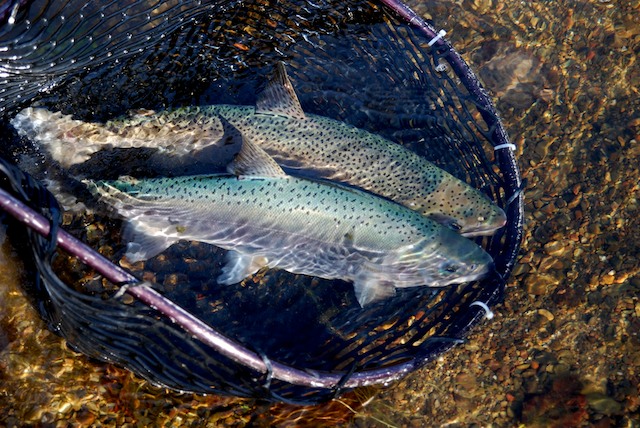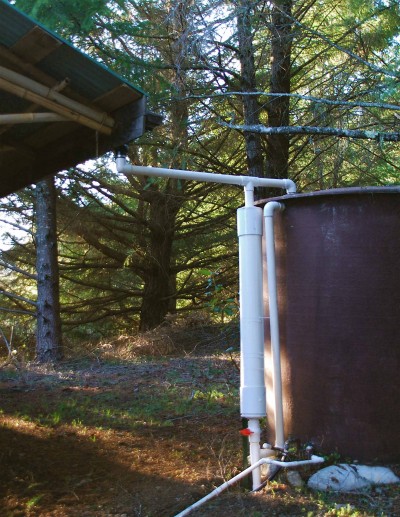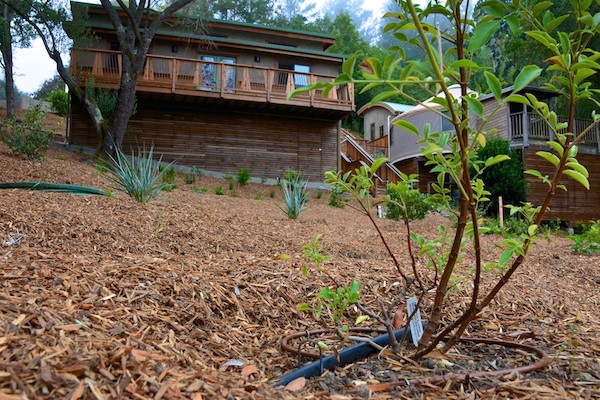These are extraordinary times in California–especially in the Dutch Bill Creek Watershed, where OAEC is located, and the watersheds surrounding it. The water in our creeks is so low that the already threatened coho salmon species is in great peril. In response to this mounting issue, OAEC’s WATER Institute helped found the Russian River Coho Water Resources Partnership to develop a systematic approach to improving streamflow and water supply reliability in five Russian River tributaries critical to the recovery of endangered coho salmon. One of our organization’s goals is to encourage community-based implementation of water conservation best practices at a watershed scale.
 Successful water conservation requires education to improve awareness and inspire people to use less. Our WATER Institute researches and tests regionally-appropriate water efficiency strategies, then disseminates the findings for public education. To inform our regionally-focused work, we have been implementing Conservation Hydrology practices for nearly two decades here on the 80-acre demonstration property we steward—capturing rain, conserving the water we have, and reusing as much as we can.
Successful water conservation requires education to improve awareness and inspire people to use less. Our WATER Institute researches and tests regionally-appropriate water efficiency strategies, then disseminates the findings for public education. To inform our regionally-focused work, we have been implementing Conservation Hydrology practices for nearly two decades here on the 80-acre demonstration property we steward—capturing rain, conserving the water we have, and reusing as much as we can.
Now that regional water restrictions from the State Water Board are in place, OAEC is embracing this opportunity to provide you with drought resources (compiled by the WATER Institute) and to articulate the measures we are taking, especially in our California Certified Organic farming operation, to be Conservation Hydrology-focused.
OAEC Water Conservation Practices
 Watering from an off stream, surface water-filled pond. Our ag pond is rain-fed in the winter and keeps us from relying on groundwater or coho habitat creeks to sustain our gardens.
Watering from an off stream, surface water-filled pond. Our ag pond is rain-fed in the winter and keeps us from relying on groundwater or coho habitat creeks to sustain our gardens.- Watering only 1-2 times weekly. We employ both drip irrigation and overhead watering depending on need (see further explanation below).*
- Planting drought tolerant plants, many of which are cultivated at the OAEC Nursery.
- Maintaining an abundance of organic matter in the soil through compost, manure and mulch in order to increase the moisture holding capacity of the earth.
- Densely planting food crops creates a living mulch that conserves water by cutting down on water loss from the soil.
- Utilizing roofwater catchment in the winter to augment our dry season water supply.
- Utilizing graywater to water our orchards.
*A narrative we sometimes hear from visitors to OAEC is that overhead irrigation, especially in the daytime due to evaporation, is inefficient. New regulations underscore this, limiting residential irrigation to 8pm-8am two days a week. The OAEC Mother Garden Biodiversity team utilizes overhead watering 1-2 times weekly because it mimics rain—a strategy to cultivate living soil that has been used onsite in our gardens since the Farallones Institute stewarded this land. Overhead watering also nourishes the perennial cover crops we have planted as pathways in between our garden beds, which is an important part of our strategy to build soil fertility onsite—when we mow the living pathways, we harvest the nitrogen-rich trimmings for mulch or sheet compost. While it would be ideal to water very early or late in the day, our current management system restricts us to daytime overhead irrigation.
OAEC Site Design
Here at the Occidental Arts & Ecology Center, we have taken great care to design our roofs, landscapes and waste water systems to maximize rain-, storm-, gray- and blackwater. Our site includes habitat ponds, infiltration ditches, rain gardens, roofwater harvesting, low flow appliances/fixtures, laundry-to-landscape and branched drain graywater systems, and septic systems that release water to the root zones of perennial vegetation.
Our new guest housing units were especially built with conservation in mind. Read our blogpost about them.

Thank you for your interest in water conservation. In this time of severe drought, it is more important than ever to protect and cherish our water. Join us!
Check out the OAEC WATER Institute’s drought resources >
